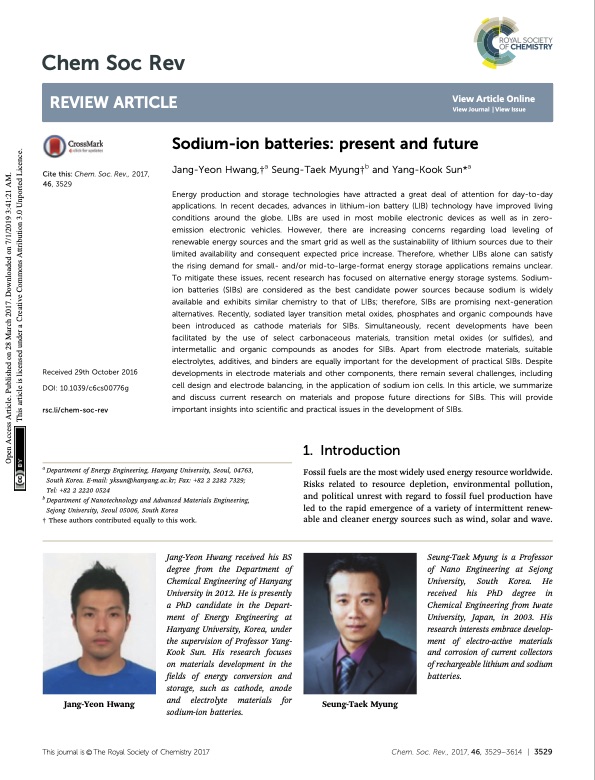
PDF Publication Title:
Text from PDF Page: 002
Chem Soc Rev REVIEW ARTICLE View Article Online View Journal | View Issue Cite this: Chem. Soc. Rev., 2017, 46, 3529 Sodium-ion batteries: present and future Jang-Yeon Hwang,†a Seung-Taek Myung†b and Yang-Kook Sun*a Energy production and storage technologies have attracted a great deal of attention for day-to-day applications. In recent decades, advances in lithium-ion battery (LIB) technology have improved living conditions around the globe. LIBs are used in most mobile electronic devices as well as in zero- emission electronic vehicles. However, there are increasing concerns regarding load leveling of renewable energy sources and the smart grid as well as the sustainability of lithium sources due to their limited availability and consequent expected price increase. Therefore, whether LIBs alone can satisfy the rising demand for small- and/or mid-to-large-format energy storage applications remains unclear. To mitigate these issues, recent research has focused on alternative energy storage systems. Sodium- ion batteries (SIBs) are considered as the best candidate power sources because sodium is widely available and exhibits similar chemistry to that of LIBs; therefore, SIBs are promising next-generation alternatives. Recently, sodiated layer transition metal oxides, phosphates and organic compounds have been introduced as cathode materials for SIBs. Simultaneously, recent developments have been facilitated by the use of select carbonaceous materials, transition metal oxides (or sulfides), and intermetallic and organic compounds as anodes for SIBs. Apart from electrode materials, suitable electrolytes, additives, and binders are equally important for the development of practical SIBs. Despite developments in electrode materials and other components, there remain several challenges, including cell design and electrode balancing, in the application of sodium ion cells. In this article, we summarize and discuss current research on materials and propose future directions for SIBs. This will provide important insights into scientific and practical issues in the development of SIBs. Received 29th October 2016 DOI: 10.1039/c6cs00776g rsc.li/chem-soc-rev a Department of Energy Engineering, Hanyang University, Seoul, 04763, South Korea. E-mail: yksun@hanyang.ac.kr; Fax: +82 2 2282 7329; Tel: +82 2 2220 0524 b Department of Nanotechnology and Advanced Materials Engineering, Sejong University, Seoul 05006, South Korea † These authors contributed equally to this work. 1. Introduction Fossil fuels are the most widely used energy resource worldwide. Risks related to resource depletion, environmental pollution, and political unrest with regard to fossil fuel production have led to the rapid emergence of a variety of intermittent renew- able and cleaner energy sources such as wind, solar and wave. Seung-Taek Myung is a Professor of Nano Engineering at Sejong University, South Korea. He received his PhD degree in Chemical Engineering from Iwate University, Japan, in 2003. His research interests embrace develop- ment of electro-active materials and corrosion of current collectors of rechargeable lithium and sodium batteries. Seung-Taek Myung Jang-Yeon Hwang Jang-Yeon Hwang received his BS degree from the Department of Chemical Engineering of Hanyang University in 2012. He is presently a PhD candidate in the Depart- ment of Energy Engineering at Hanyang University, Korea, under the supervision of Professor Yang- Kook Sun. His research focuses on materials development in the fields of energy conversion and storage, such as cathode, anode and electrolyte materials for sodium-ion batteries. Thisjournalis©TheRoyalSocietyofChemistry2017 Chem.Soc.Rev.,2017,46,3529--3614 | 3529 Open Access Article. Published on 28 March 2017. Downloaded on 7/1/2019 3:41:21 AM. This article is licensed under a Creative Commons Attribution 3.0 Unported Licence.PDF Image | Sodium-ion batteries present and future

PDF Search Title:
Sodium-ion batteries present and futureOriginal File Name Searched:
Sodium-ion batteries present and future.pdfDIY PDF Search: Google It | Yahoo | Bing
Salgenx Redox Flow Battery Technology: Salt water flow battery technology with low cost and great energy density that can be used for power storage and thermal storage. Let us de-risk your production using our license. Our aqueous flow battery is less cost than Tesla Megapack and available faster. Redox flow battery. No membrane needed like with Vanadium, or Bromine. Salgenx flow battery
| CONTACT TEL: 608-238-6001 Email: greg@salgenx.com | RSS | AMP |